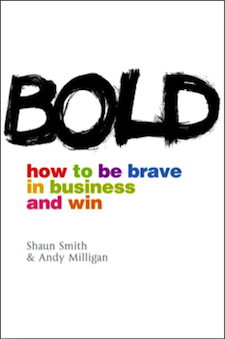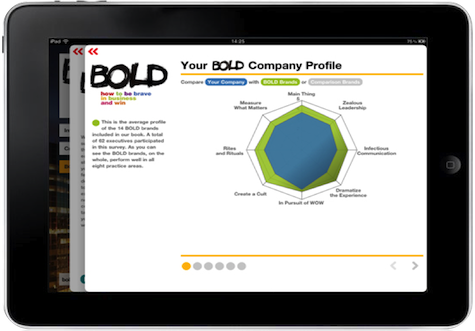Johannes Gutenberg invented the printing press around 570 years ago and the reading experience hasn’t changed much since. Almost every other form of communication has changed beyond recognition, yet we still read in largely the same way as our ancestors did in medieval times.
But what about the Kindle, the iPad or, indeed, any of the other forms of e-publishing? Surely they are very different from the books we grew up with. But although the medium has changed, the user experience has not. Usually, books are simply converted into a digital format and people read them on their e-reader in largely the same way as they would a print version: sequentially and chapter-by-chapter.
As a means for communication, publishing is very inefficient; there are estimated to be 11,000 business books published every year in the U.S. and yet the average U.S. nonfiction book sells less than 250 copies per year and less than 3,000 copies over its lifetime. According to some estimates, only a small percentage of the books bought will actually be read cover to cover. There is a huge supply of some 250,000 plus business books fighting for limited store space and it has been calculated that the average book now has less that a one percent chance of being stocked.
And the situation will get worse. The major bookstore chains have seen a 12% sales decline between 2007 and 2009 and some have gone out of business as a result. Publishers’ distribution centers are projecting a 25% volume decline over the next five years. There will be more consolidation leading to store closures and less net store space in the future. Of course, the growth in online retailing will fill some of this void. Nevertheless, an increasing number of books are vying for an ever-shrinking market. Book sales in the U.S. peaked in 2007 and then fell by nearly five percent between 2007 and 2009 and the trend has continued.[*]
If you put all of this together—a poor user experience, inefficient distribution, and a broken commercial model—you begin to see that we are at a moment when significant change is needed. Andy Milligan and I have just finished two years of research into brands that are transforming their markets. The culmination of that research is our new book called Bold: how to be brave in business and win, and it tells the story of 14 brands that are doing things dramatically differently—from AirAsia X re-inventing the economics of long haul aviation to Zappos transforming the online retailing experience.
What struck us about these brands was their ability to challenge conventional wisdom and completely reinvent their business models. As we discussed the book with our publishers we said, “Why don’t we do the same and turn the reading and publishing experience on its head?” We therefore decided to take a “bold” approach to publishing the book and create a dramatically different user experience.
We began with a blank sheet of paper and asked ourselves, “Forgetting what reading is like now, what should the user experience of reading be like in the future?” From this initial question we derived a series of principles:
- It should be interactive. Most reading experiences are passive; a well written book may evoke a reaction in you but you cannot really interact with it. We decided to create a way for readers to interact with our content and relate it to their own experience by comparing their responses to those of the brands we studied.
- It should offer content tailored to the interests of the reader. Some books are read cover to cover if they are very good, but more often they are only dipped into if they are not exceptional or if the reader is seeking just the more interesting or relevant content. We decided to make the reading experience customized and potentially different for every reader by curating the content based on their organizational needs or their own functional areas of interest. In other words, suggesting content that we believe is likely to be of greatest relevance to readers based on our research and their profiles.
- It should be sold on value, not price. A book is usually sold at a recommended retail price or at a deep discount via retailers such as Amazon based how much the retailer wants the title to “move.” This commodotizes the market and results in slim returns for both publishers and authors. But what if, instead of regarding the book as a single item, we looked upon it as a bundle of content, some of which would be of greater value to the reader than other parts? This scenario provides the opportunity to price the content according to the value it represents to reader rather than the price the retailer wishes to sell it for.
- It should offer additional material that allows the reader to engage at a deeper level. When an author writes a book, he is essentially making a decision about how much, or how little, the reader needs or wants to know about the subject at hand. Yet people vary enormously, so we decided to create a facility for the reader to be able to select “e-features”—links that take the reader to video, web pages, and even music that relate to the people and brands that we wrote about and that resonate with the interests of the reader.
- It should tie into the digitally connected world where people use social media to share their thoughts, preferences and recommendations. We wanted people to talk about our book and, if they like it, recommend it to their friends. We therefore added a social media function to our wish list as well as the opportunity for the reader to send feedback to the authors.
Having determined our goals for the reader experience of our book, we then met with our publisher, Kogan Page, to review how we might achieve them. Fortunately, they shared our vision and passion and a joint brainstorming session led to the decision to embed the book entirely within an iPad app (a publishing first) as well as to offer it in the conventional printed and e-pub formats. We felt that the terrific functionality of the iPad along with its rapid adoption would make it an ideal platform for an enhanced reader experience.
The next step was to engage a developer (Spacebar Interactive) and to align our objectives in two ways:
- The publisher and authors needed to agree on the overall purpose and function of the app and its relationship to the printed book.
- The developer needed to understand the authors’ and publisher’s vision and give digital shape to it.
The importance of a shared approach and objectives between the publisher, authors, and the developer cannot be overstated; they needed to become a team. This is significantly different to the traditional, arms-length approach in which the author creates the content and only really engages with the publisher after completion.
The result of this collaborative approach is an iPad app and book of the same name: BOLD: how to be brave in business and win. The app includes a self-assessment tool that users can complete to assess how bold their organizations are compared with the 14 brands profiled in our book. It then highlights those areas on which the reader needs to focus and offers useful recommendations and tactics to improve performance.
Most importantly, the app makes it simple for readers to choose content that is curated for them. They can purchase individual chapters specifically recommended based on their organizational profile or on their job function and then view the selected chapters immediately within the app. They simply use their iTunes account to unlock the chapters or the book that are already resident within the app—no additional downloads, no hassle. We believe this is a first in book publishing.
This custom-tailored content experience is the basis for premium pricing the curated chapter recommendations and offering, in effect, content on a sliding price scale. The recommended chapters are cheaper than the whole book, but more expensive than they would be on a pro rata basis because of the greater value of the content and relevance to the reader. If the user then goes on to purchase other chapters, the sliding scale pricing automatically adjusts so if users ultimately purchase all of the chapters, they will never pay more than the recommended retail price, just as if they had purchased the complete book straight away.
The reading experience is further enhanced by the e-features in each chapter that suggest multimedia content to the reader. And if the user takes a break from reading, there is a very cool screen saver function showing images from the brands featured as a slideshow. Finally, the app allows users to email their “Bold profiles” to themselves or colleagues and to share their views via Twitter or Facebook from within the app. We believe that the publishing world needs to take a bold approach and utilize the functionality of the new platforms to re-think the reader experience allowing people to interact with the content, customize it to their interests and then share their views comments via social media from within the book.
Ray Davis, President of Umpqua Bank and one of the leaders we interviewed said, “When you put customer experience in a design where it can flourish, you have something incredible.” We believe the innovative approach we’re pioneering with our book, married with the functionality of the iPad and other platforms, will create an incredible new reading experience and offer the potential to put new energy into the book market. The “print and pray” approach to publishing is showing its age and it is clear that marketing efforts will have to become much more focused and imaginative if publishing is to overcome the malaise in the market. This in turn will require a new business model whereby the parties share risk, reward, time, and effort.
If the printed works are to survive against the easily digested micro-content offered by blogs, Twitter, YouTube, and the like, the reading experience has to become much more exciting, engaging, and valuable. This is not the time for business as usual, and authors and publishers need to reinvent their relationships with their readers. We believe the approach we have taken is perhaps a first attempt at creating a new model for publishing. We hope Gutenberg would approve!

You can download the free Bold: how to be brave in business and win iPad app from the Apple Store to compare your own organization with the bold brands.
To see a video of the app being used go to www.boldthebook.com.
Bold: how to be brave in business and win is published by Kogan Page in May 2011.





